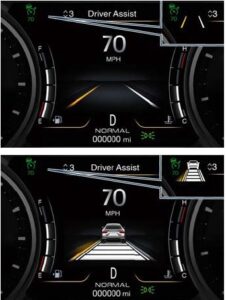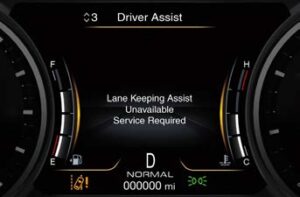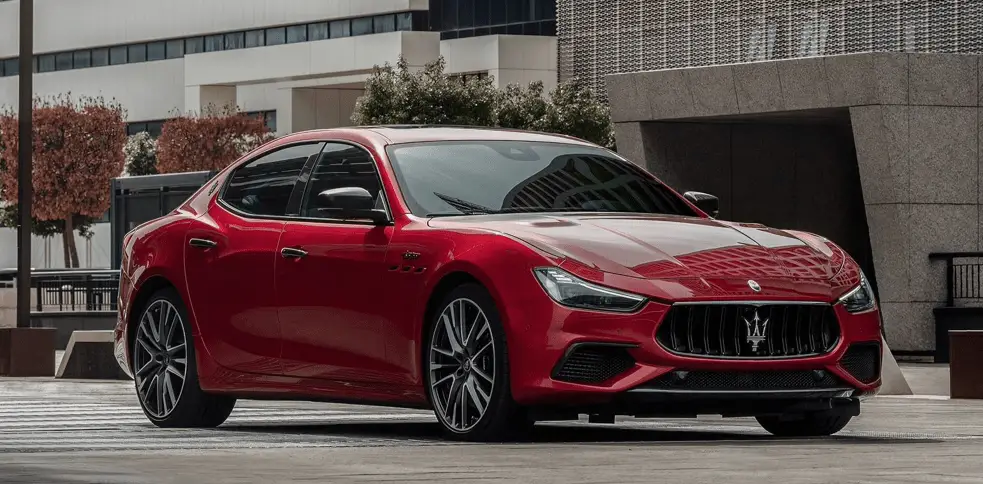Maserati Ghibli 2023 Lane Keeping Assist User Manual
Introduction
A luxury sports car with cutting-edge technology and beautiful Italian craftsmanship is the Maserati Ghibli 2023. The Lane Keeping Assist system on this fantastic car is one of its best qualities. The Lane Keeping Assist feature makes use of cutting-edge sensors and clever algorithms to help keep the car in its allotted lane. It was created to improve driver convenience and safety. The Maserati Ghibli 2023 uses camera-based and radar-based technologies in conjunction with lane keeping assist to track the position of the car on the road. The device tracks the movement of the car and continuously scans the road markings to give the driver input in real-time.
The technology performs mild corrective actions to bring the automobile back on course if it notices that it is unintentionally drifting out of its lane. To alert the driver to make the necessary modifications, this can involve minor steering interventions or haptic input through the steering wheel. Long highway drives or periods of driver tiredness, when unintended lane departures are more likely to happen, make Lane Keeping Assist particularly useful. The function improves driving safety by assisting in maintaining proper lane location and lowering the possibility of collisions or accidents brought on by lane drifting.
Lane Keeping Assist
This system was designed especially for highway or freeway driving, to reduce the risk that the vehicle, under particular circumstances, accidentally departs from the lane in use. When this happens, graphic instructions on instrument cluster display together with steering torque application and steering wheel vibration (depending on the distance to the line and the setting that the driver has chosen from the “Settings” menu on MIA as described in “Customized Settings” of this chapter) warn the driver that the vehicle is going out of the lane initiates a steering maneuver to try to prevent the lane exit. To detect lane lines, the system uses the forward-facing camera behind of the rear-view mirror, which is the same one used also by the lighting system to manage the automatic high beams. The logic core is in the front radar. LKA system remembers the condition it was in before turning off the vehicle. Refer to “Functions of Controls Menu on MIA” in section “Dashboard Instruments and Controls” for further information.
NOTE:
In case of wet road or raining conditions the function could be disabled by the system in order to minimize the risks.
Speed Range of Use
| Speed | MPH (km/h) |
| Minimum | 37 (60) |
| Engaged/activated | 37 (60) |
| Maximum | 112 (180) |
- Customized Settings
LKA is configurable by the driver in order to maximize its efficiency based on the driver driving style and the expectation of the system, reducing at the same time the possible invasiveness.
Entering “Settings” menu of the “Vehicle” page on MIA display the driver can see the current setting beside the “Lane Keeping Assist” soft-key.
Touching “Lane Keeping Assist” soft-key to enter the setting page.
Driver warnings are “Visual & Haptic” (default mode). System response can be set to “Early”, “Medium” (default mode) or “Late”. System reaction force can be set to “Low”, “Medium” (default mode) or “High”.
Meanings of Settings
- “Visual & Haptic”: the system will apply steering torque when lane departure is detected while showing at the same time the proper cluster indication, adding to this steering vibration when the departure is very imminent. When “Visual & Haptic” is selected and LKA is enabled then the following menu will be used by the system.
- “LKA Sensitivity”: it tunes the distance to the lane boundary where the system will start to apply steering torque.
- “LKA Strength”: it tunes the steering torque value to have a stronger or weaker directional correction/deviation.
WARNING!
In rare cases, Lane Keeping Assist (LKA) may make an inappropriate steering torque application. LKA may be interrupted at any time by counter steering. Lack of driver attention may lead to serious injury or death
System Availability
The ADAS systems help the driver while driving. These systems can be set and monitored simultaneously on the display, after opening “Driver Assist” menu (see paragraph “TFT Display:
Menu and Submenu Content” in section “Dashboard Instruments and Controls”). When you are not in the “Driver Assist” page, the system status is indicated by a notification at the top left of the TFT display. LKA is designed for an attentive driver; therefore the system is available only when his/her hands are on the steering wheel or with hands off only for a very limited amount of time. When the system is enabled it will trigger cluster warning in case at least one hand is not detected on the steering wheel. The torque application as well as the vibration are suppressed/inhibited in case of: high driver torque in the steering wheel, high lateral acceleration, trailer connected to the proper control module, hands not on the steering wheel detected for more than a certain time. High dynamic driving behaviors, driving on the lane boundary, or driving off course will prevent the function from working. FCW braking and stability system interventions (ESC, ABS) will also prevent the system from operating. Changing lanes results in system inhibition for a certain time. In addition, the driver must respect some road characteristics such as minimum-maximum width, lanes clearly defined by two lane boundaries and only in limited Driver Assistance Systems cases for a limited time, the presence of at least one lane boundary. The LKA system is active both in the case of both lines visible and available for the system, and in case of the only line available on the road. Each LKA intervention is notified to the driver with the relative graphics which is shown for the entire duration of the system intervention and for a minimum time of 1 second. Multiple interventions are allowed both in terms of visual and acoustic signals and in terms of steering torque. If more then three consecutive interventions are required within a period of 180 seconds, starting from the second intervention the acoustic signal will last 10 seconds longer the previous one. Starting from the third acoustic signal the system will emit a continuous sound and a message on TFT display will indicate to keep the center line.
NOTE:
- In case of wet road or raining conditions the function could be disabled by the system in order to minimize any risks.
The system is developed to work only on the lines painted on the road surfaces, but it may happen that shadows, traces of old lines, road edges, etc. are also interpreted as such. - Being this function used to prevent unintentional lane change/lane drift, it will be temporary suppressed/inhibited by a turn indicator activation, therefore, graphic warning, steering torque application and vibration will be terminated. In these conditions the graphics turn gray.
Function Description and Operating Mode
- The function intent is to prevent the lane departure by warning the driver through indication on the cluster and if set applying steering torque and vibration. The graphic which intent is to represent at the glance the system knowledge of the lane in front of the car, the system suppression status and warning. For this a simple color code has been adopted for each line (of the two presented):
- Both gray lines means system is enabled, not able to operate (suppression condition present or lane detection system not able to estimate properly the lane);
- Left/right gray line: the lane detection system is not able to detect that specific lane boundary;
- Yellow line: there is a steering torque intervention in progress that tries to prevent a departure on that side, in this situation the warning should increase the driver attention requiring him/her to properly handle the situation;
- Yellow flashing line: the graphic is shown whenever the system detects a very imminent lane departure, at this can be added torque and steering vibration if configured by the customer.
The white lines (one or both) indicates that the corresponding lane boundary is detected and the system is capable to intervene on it.
Whenever the system is enabled there will be graphic on the dedicated screen of the “Driver Assist” page. This graphic will be available in the form of symbols (see detail in figure) in the top left corner of the cluster screen.
An example of this screen, with only LKA system activated and with LKA and ACC systems activated, can be found in the following figures:
In the first, only LKA system is activated, steering torque in progress to correct the trajectory towards the lane center.| - In the second LKA and ACC systems are activated, car is crossing the lane boundary, steering torque and vibration if configured are in progress when this graphic is shown.

The icons that represent the status of the ADAS systems remain displayed even when you exit the “Driver Assist” screen.
System Limitations
Because of physical limits, in order to properly operate, the system needs good visibility (it might not work or not properly operate in case of heavy rain, snow, wet roads, fog, direct sun on the camera, etc.).
NOTE:
The sensors are not able to detect the presence of the hands on the steering wheel areas covered in wood, plastic bezels or carbon inserts (where present). Sharp turns, slopes and change in slopes, poor lane boundaries, as well as construction areas and all the scenario described in this paragraph may challenge the system, therefore be always ready to prevent any unexpected behavior of the car. Damaged front bumper, windshield replaced without proper technical intervention may also lead to system malfunction or system unavailability. Other conditions such as fault, but
not explicitly indicated here may also prevent/interrupt the system intervention.
WARNING!
If the driver fails to adapt his/her driving style, Lane Keeping Assist (LKA) can neither reduce the risk of an accident nor override the laws of physics. It cannot take into account road, weather or traffic conditions. Active LKA is only an aid. Driver is always responsible for the distance to the vehicle in front, for vehicle speed, for braking in good time and for staying in lane.
System in Fault
When the LKA cannot properly operate due to a fault of its components or because the windshield in front of the forward facing camera is dirty, the amber light and/or the corresponding message will be displayed.
If message suggestion does not allow fixing the fault, do not use the system and have the vehicle inspected at an Authorized Maserati Dealer.
Radar Device – Regulatory Information
The “Regulatory Information” for all the radio frequency and radar devices can be consulted by accessing the “Services” section on the website www.maserati.com.
FAQs
- What is Lane Keeping Assist in the Maserati Ghibli 2023?
Lane Keeping Assist is a safety feature in the Maserati Ghibli 2023 that provides steering assistance to help the driver maintain the vehicle’s position within the lane. - How does Lane Keeping Assist work?
Lane Keeping Assist monitors the vehicle’s position within the lane using sensors or cameras. If the vehicle begins to stray from its lane without signaling, the system provides gentle steering inputs to guide it back into the lane. - Can Lane Keeping Assist be customized or adjusted?
Lane Keeping Assist customization options may differ depending on the vehicle specifications. In some cases, the sensitivity or intervention levels of the vehicle can be adjusted via the settings or infotainment system. - Does Lane Keeping Assist work at all speeds?
Lane Keeping Assist is typically capable of operating at a variety of speeds, including highway and city driving conditions. The specific speed range, however, may be determined by the system and its capabilities. - Can Lane Keeping Assist detect and respond to all types of road markings?
Lane Keeping Assist is intended to work in a variety of weather conditions. Extreme weather conditions, such as heavy rain, snow, or fog, may, however, impair its performance. It is critical to keep a clear view of the road and adjust driving behavior accordingly. - Can Lane Keeping Assist be disabled or turned off?
Lane Keeping Assist is designed to keep the vehicle in its current lane and may not actively detect or respond to vehicles in adjacent lanes. Some advanced systems, on the other hand, may offer additional monitoring capabilities. - Can Lane Keeping Assist work in all weather conditions?
Lane Keeping Assist typically does not necessitate any additional maintenance beyond standard vehicle maintenance procedures. However, for optimal performance, keep the sensors and cameras clean and free of dirt or debris. - Can Lane Keeping Assist detect and respond to vehicles in adjacent lanes?
Lane Keeping Assist can be combined with other safety features like Adaptive Cruise Control or Forward Collision Warning. These features complement one another to improve overall safety and driver assistance capabilities. - Does Lane Keeping Assist require regular maintenance?
Lane Keeping Assist can be used on curved or winding roads in general, but its performance may vary depending on the system and road conditions. It is critical for the driver to remain alert and adjust their driving style accordingly. - Can Lane Keeping Assist be used in conjunction with other safety features?
The availability of Lane Keeping Assist for the Maserati Ghibli 2023 may vary depending on the trim level and package selected. For more information, contact your dealership or look over the vehicle’s specifications. - Can Lane Keeping Assist operate on curved or winding roads?
While Lane Keeping Assist can help prevent unintentional lane departures, it cannot guarantee that all lane departure incidents will be avoided. It is a driver assistance feature, and the driver must remain alert, maintain control of the vehicle, and practice safe driving habits. - Is Lane Keeping Assist available as a standard feature in the Maserati Ghibli 2023?
Because the system primarily detects standard road markings, Lane Keeping Assist may have limitations in construction zones or areas with temporary lane markings. It is critical for the driver to be cautious and adapt to changing road conditions. - Can Lane Keeping Assist prevent all lane departure incidents?
Lane Keeping Assist is a driver assistance feature that should not be used in place of driver attention. It is intended to assist the driver but does not take the place of the driver’s responsibility to actively monitor the road, make safe driving decisions, and maintain control of the vehicle.
Useful Links
View Full User Guide: Maserati Ghibli 2023 User Manual | Auto User Guide
Download Manuals: On-Board Owner Documentation | Maserati


